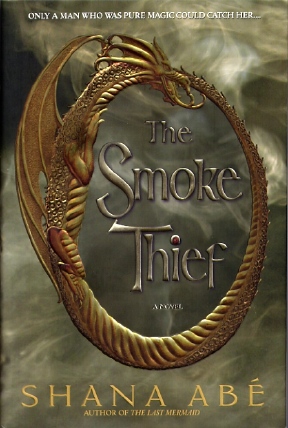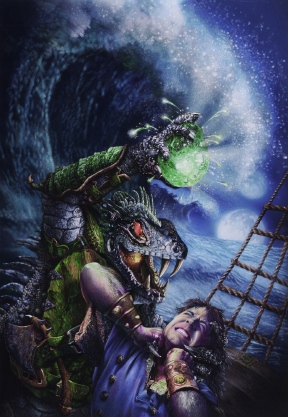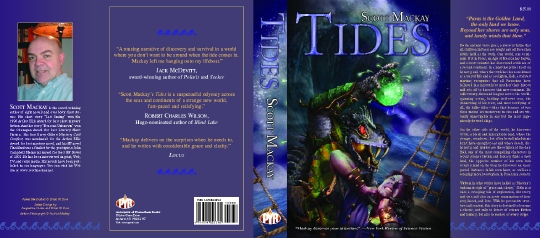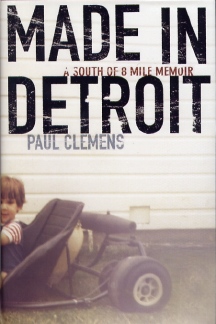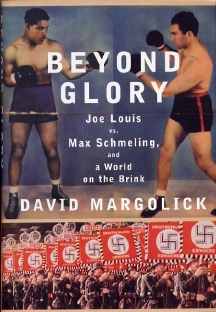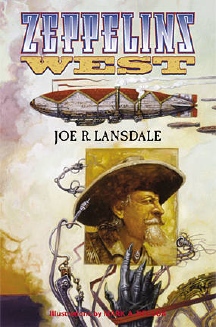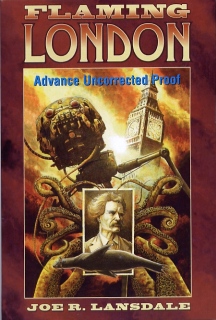|
|
|
This Just In...News from the Agony Column
|
09-23-05: Shana Abé's 'The Smoke Thief'; Drool No More! |
|||
Were-Dragons
Go HC
Yes, for a fantasy it is on the slim side; a mere 294 pages. It's the first of a trilogy, which, if they preserve the cover price will cost you less than two books in the average fantasy trilogy, and if they keep the length, use up less of your reading life as well. The whole publishing aspect of this novel is quite interesting and fairly, well -- novel. As nicely packaged as it may be, one can't exactly apply "novel" to the idea at the core of 'The Smoke Thief'. Our old friends from the Alan Troop novels, 'The Dragon Delasangre' and 'Dragon Moon' -- were-dragons -- are at the core of 'The Smoke Thief'. As is the idea of turning the story of were-dragons into a romance. Well, maybe that's an obvious twist to others, but it seems counter-intuitive to me. I tend to see dragons more as monsters than, uh lovers. Be that as it may, Abé has added a few twists of her own. 'The Smoke Thief' is a daring jewel thief, confounding 18th century London police by doing things like walking through walls and vanishing into thin air. Of course, Kit Christhoff, the young leader of the drakón, knows exactly what's going on. What he doesn't know is that The Smoke Thief is half-human, half-drakón, and -- all woman. The drakón are a tribe of were dragons that have been living in seclusion in Northern England in the 18th century. Theyve kept themselves to themselves and been rather successful, so this upstart calling attention to them is unwelcome, except that well, she's a babe, and that rare female drakón who can do the change. So she's special, so special. It's pretty easy to see where this is going -- straight down the road to period crime, fantasy and romance. And I can understand how this must have looked to the publishers. I have to admit that the period stuff looks to be done well, and the narrative is pretty zippy. And only fifteen dollah! Still, one must, having just read Terry Pratchett's 'Thud!' wonder about the physics of it all. I mean, are these small dragons? Like mini-dragons, or are they the full-size, fire-breathing real deals? If the latter then, uh, where do they get the mass? Pratchett relentlessly calculates the size of his were critters and makes them equate; one vampire breaks down into about 125 bats. I hope Shana Abé pays attention to such matters. It does make the work so much more enjoyable. But readers who are looking for, in this order, fantasy, romance, and period settings, will doubtlessly be delighted. Like Tor, Bantam is pursuing the ever-growing fantasy romance market segment. But where Tor is marketing their Paranormal Romance line as mass market paperbacks at say eight bucks a pop (must be a killer profit margin there), Bantam is taking a different approach. They're going after the fantasy romance readers using a very up-market look and feel, coupled (note appropriate word choice) with a dirt-cheap price for a very nicely put together book. With a book this short, and so many desirable elements woven in to that compact size, 'The Smoke Thief' might have a pretty big appeal. You've got, crime, fantasy, period, romance; make the drakón aliens, give 'em spaceships and maybe pet vampires and you'll have a book that is all things to all people. On second thought, maybe not. Ah, a glance at the back of the DJ explains the cover appeal; its Stephen Youll doing the illustration and Jamie S. Warren Youll on the design. Nice stuff. Bantam has paid for the best and got it. Theyve done something very smart; paid not only for a nice illustration but they've paid for a nice design. Too often you'll see a great illustration that is essentially, a sort of dumb pitcher. It's unfortunate to see that kind of waste of resources. You know, 'The Smoke Thief' is probably not for me. Though I'll confess (note appropriate word choice) the period/crime aspect is appealing. But for the target audience, this seems like a dead-on perfect fit, nicely assembled with attention to details and no fat. Perhaps that's Bantam's best move yet; putting fantasy on a diet. |
|||
Sarah
Ash Has Shed the Final Tears of Artamon
As to what has come to pass in the Empire of New Rossiya, well, remember my crack about pet vampires above? Here we have dragons possessing humans and turning them into something suspiciously resembling a vampire. I mean, feeding on the blood of innocents just does not leave you innocent. Even if youd prefer not to. I think if you drink the blood of innocents, well, that's crossing a line that you cannot come back from, even if you were possessed at the time. That's my story and I'm sticking to it. As Ash has admirably stuck to hers, delivering a nicely multilayered fantasy saga with hooks for those who like their fantasy on the horrorific side (that's me) and, I'm guessing, more romance than the average military thriller. But unlike the above, this is not primarily a romance. This novel looks set to deliver the goods for those thirsting after complicated political fantasies with lots of running about. The prose is rather nice, and I'm not just reflecting my Anglophile tendencies because the author is English. Bantam has brought in the same design team (Stephen Youll painting, Jamie S. Warren Youll designing) with the same fine results. I like the colors and the vista on this cover, though the scene is pretty much standard-issue. And no, this book is not a mere fifteen dollah; nor is it a mere 294 pages. You're getting your standard fantasy length of 511 pages here, a big fat book. And that gives the readers a choice in their fantasy diet. Slim and trim, or fat and sassy? Or, if Bantam have their way, both. |
|
09-22-05: A Conversation with Jeff Ford |
|||
Calling
All Spirits
It's not like it should be hard to find. Ford is an acclaimed writer. But the combination of the anonymous cover and the where-do-we-shelve-this problem has resulted in the publication of a great book that is all too invisible. I don't know how it is with the bookstores round you, but here in Santa Cruz, surely an enlightened city, 'The Girl in the Glass' is likely to be piled on a table with other literary fiction trade paperbacks, and there's no way youd look at it unless you knew just what you were looking for. Well, now you know. In Borders, you'll need to look amidst what is called general fiction. But an independent might decide to shelve it with the "sci-fi" novels, since Ford's first three novels -- 'The Physiognomy', 'Memoranda' and 'The Beyond' were all slotted there. And his short story collection from Golden Gryphon, 'The Fantasy Writer's Assistant' has the word "fantasy" which to the shelving mind of the bookselling community world DEMANDS it be put with the fantasy novels. And maybe that's best, but I imagine readers like me are truly confused as to where to look to find the Jeffrey Ford novels. If you have to ask, by all means ask. Jeff Ford is worth looking for. I had the pleasure of talking with Jeff Ford at Worldcon, and now AT LAST, I can finally let readers in on the interview I did with him. As one might expect with a novel about spiritualist con-men during the great depression, the genesis of the novel is nearly as interesting as the novel itself. "My stuff isnt what you would call genre quote unquote science fiction," he told me. "But it all fits under the umbrella of the literature of the fantastic." It also happens to be, to my mind, simply fantastic literature. I've uploaded Ford's interview in both MP3 and RealAudio formats. This is a rare chance to hear one of the great writers in that weird land without genre. But be warned -- you'll want to buy the book once you hear the interview. Readers of all spirits will find it utterly entrancing; there's not a reader on the planet who would not enjoy 'The Girl in the Glass'. Kleffel Predicts! |
|
09-21-05: Scott Mackay Rides the 'Tides' |
|||||
Pyr's
November Hardcover
Trust Lou Anders over at Pyr to make that happen, with the upcoming release of 'Tides' (Pyr / Prometheus Books ; November 2005 ; $25 HC). 'Tides' is classic, no-excuses, scare-the-parents science fiction. The premise is quite simple. On an unnamed planet, two intelligent races inhabit distant continents. Paras is a lush continent, offering ample natural resources so that nobody needs to knock themselves out. The culture that has arisen there is based around kindness and honesty. Nice begets nice. Ortok, on the other hand is a bleak volcanic nightmare. The species that lives there barely ekes out a living. It's subsistence level at best. The culture of those living there is a culture of cruelty and deceit. Ugly begets ugly. So what happens when nice and ugly finally meet up? 'Tides' explores the clash between two cultures and the conflicts that emerge within both cultures upon that meeting. Now, obviously, were not talking a very complicated or even unusual science fiction setup here. But what we are talking about is attention to detail, a writer who can explore this classic premise with depth, clarity and a vivid imagination. Oh, and guaranteed-on-the-front-cover monsters. Mackay brings some very impressive credentials to the party. In spite of the scare-your-parents, in-your-face Sfness of this novel, Mackay is not an SF-only writer. He's won literary awards for short fiction and been nominated for the mystery awards for his detective novels. He's written nine, count 'em, nine novels. So when you pick up this novel, you're getting a lot more than throttling monsters, though, heaven knows that's probably enough to send me to the front of the line. Readers who enjoy a bit of a nautical bent to their fiction will also want to take a peek at this, as this culture clash plays out largely on the oceans that separate the two cultures. So, kindness and honesty versus cruelty and deceit – who do you think wins, eh? And who do you think is who? That is, digging the cover is certainly a part of the experience of this book for me, at least. So here's the deal on the on cover. What we have here are two images, thanks to the fine efforts of Mr. Anders. No, I've not totally lost interest in creating those big ol' galleries, so should you wish, you can view the whole images and not just the reduced-for-this-page versions.
So, what we have here are two images from cover artist Brian Dow; one of the dust jacket with a not-final version of the painting and one of what I believe to be a pretty-much final version of the painting. Here's what editor Lou Anders says..."The artist, Brian W. Dow, produces a digital under painting, then prints that out and works on it with colored pencils, where a considerable amount of the detail gets added." I've talked about Dow's work for Pyr before; he did the cover for Charles Coleman Finlay's 'The Prodigal Troll', and he's working on the cover for the forthcoming 'Genetopia'. It's gorgeous stuff, and always interesting to get a gander at the author. Moreover, it reflects the publisher's confidence in this work. Of course, the best test is to pick up the book, and then you'll find out something that shouldn't, in retrospect, surprise you. 'Tides' reads quite a bit like a classic fantasy, the kind of fantasy that partakes of science fictional tropes. It starts in a world very different from ours, and with no clear connection to ours. This isn't obviously, at least, the edge of some galactic empire. This is just a place where two very different races and cultures are duking it out – or trying to come to some sort of mutually agreeable arrangement. In 'Tides', Mackay is focusing on the bare essentials. Now this is the cover speaking to me in part, but one feel I definitely get from 'Tides' is that of an old episode of 'The Outer Limits'. I'm thinking of the one where a human and a monster are stranded on a planet for "Fun and Games"; that is, to duke it out for the entertainment of the alien overlords who set the whole deal up. Like 'Tides', that episode stripped SF down to the core, to root out some basic truths. And what more can we ask for from science fiction, or indeed any fiction, than to root out some basic truths? Well, good monsters, nicely illustrated on the cover of the book, for one thing. And in that case, it looks like the 'Tides' have come in. |
|
09-20-05: Paul Clemens was 'Made in Detroit' & David Margolick Goes 'Beyond Glory' |
|||||||||
You,
in the red shirt – Two Shots of Truth, That's Yer Limit Fella
So to get away, really get away from the genre and thus really be able to get into it, you've got to plunge headfirst into something way outside those lines. And what you'll find more often than not is that those sort of books all of a sudden seem really, really wonderful. And then when you go back to say, Alastair Reynolds, Richard, Morgan, Terry Pratchett, whoever -- well they seem more wonderful too. For me two quintessential examples of big fat, non-SF&F books that I really enjoyed are 'The Temple Bombing' by Melissa Faye Greene and 'Big Trouble' by Anthony Lukas. I've written about both of them before. They offer a bit of sort-of genre fiction interest, in that they both revolve around crimes, but only really tangentially. But what they both offer is the sort of immersive reading experience that any great book, be it SF&F, mystery, or literary fiction offers.
Detroit, however, does mean something to everyone, even the very California-fied me. And what it means ain't pretty. Apparently, the less-good, shall we say, part of time is south of some street named 8 Mile. OK, got it. That's where author Paul Clemens grew up. He was born in 1973, when the town elected its first black mayor, Coleman Young. In 'Made in Detroit', Clemens tracks his own upbringing and development against that of a major American city, which subsequently sort of went down the toilet as the American economy began its geological shift away from manufacturing. When the book begins, Clemens is sixteen, and dragged out of bed by his mother to help his father chase down the folks who just shot out the windows to their truck. Just to give you an idea of the territory. 'Made in Detroit' evolves into exactly what the cover says it is, and it explains precisely why you should give a -- well, whatever you might be inclined to give. Clemens seems to triangulate this book around his father, a fair-minded guy who likes to tinker with cars, his Catholic-school upbringing and his love of books, reading and writing. And what those three parameters enable him to hone in on is the troubled history of race relations during those years. This isn't an easy subject. We're not talking about a lot of happy endings here. The author says at one point that he wanted to write a novel in which, "The brother and sister in the book, young adults parentless in manner of Peanuts characters, find a card that their mother and father, departed for Michigan's Upper Peninsula, have left for them on the kitchen table: ' The house is yours. Please take as good care of it as everyone else in Detroit does of theirs. Ha-Ha! Love, Mom & Dad.'" Now, Clemens is quick to credit his parents with a sterling job of bring he and his sister up. But suffice it to say that this suggests the city does not have a happy history, and that Clemens got to see a fair amount of that first-hand. 'Made in Detroit' is written in a series of chapters that read sort of like short-story/memoirs. Nicely done, a good, if bleak, sense of humor underlying everything. The guy likes Flannery O'Connor, always a plus in my book. Topping out at just over 200 pages, this one is on the short side, but in wealth of detail and in-yer-face emotion looks to be fairly rich, if easy-to-read. Sidle up to it at the bookstore, pick it up and see if it grabs you. After it hits you with an aluminum baseball bat.
So, 'Beyond Glory', subtitled as you might be able to discern, 'Joe Louis vs. Max Schmeling, and a World on the Brink' focuses on a series of prize fights in the US between 1936 and 1938, but looks at them as exemplary of the world a large, world about to plunge into a righteous but ruinous World War. Like 'Made in Detroit', the book has a backdrop of racism, both in America and abroad. But though it hones in on some micro-events and offers detailed biographies of its protagonists, it's got a much larger agenda in mind. This book wants the world and it wants it THEN, "THEN" being the moments before all hell breaks loose. The book examines the ties between the Nazis and Schmeling, gazing unsparingly at the rise of Nazism in Germany the protozoic stage of civil rights in the US, and a country emerging from assort of "duh" state into the realization that it is part of the world. A big part, with the capacity to make a lot of guns, planes, the whole whatnot of war, and then throw that whatnot any which way it so pleases. With David Margolick, we're talking a detailed, intense history of a major turning point of the twentieth century. Heck, if you want to understand anything about much of the alternate history that you can buy, youd do well to pick this one up. Or if you simply want a nice, hefty dose of reality before plunging headlong into fantasies that are all-too-often reminiscent of reality. Whatever type of non-fiction you wish to read to help provide some perspective on this sorry world, you can find it out there. You walk into the bookstores you have to work to avoid it, and I know that often you do. Remember 'Death Rat'? Well, the story there is right, in that lots of folks on the publishing/agenting side dont even want to talk to you unless you're writing non-fiction. Sorry, wrong table they'll tell you. If they're repping or publishing folks like Clemens and Margolick, well, it's hard to blame them. Still maybe they need a bit of rest from all this relentless in which they immerse themselves. Dont we all? |
|
09-19-05: 'Flaming London' by Joe R. Lansdale |
||||||
The Joys of Too Much
I mean, it's not as if I dont know that anything by Joe R. Lansdale is a pretty much sure bet for me. He's on my autobuy list. Of course, the autobuy list gets truncated by fiscal reality and fickle fate. So I managed to miss actually buying 'Zeppelins West' when it first came out back in 2001. It subsequently sold out in every version you can imagine. But we can thank the fine folks at Subterranean for popping out a second edition, so that even Johnny-come-latelies like myself can get in on the ground floor before the release of 'Flaming London'(Subterranean Press ; December 29, 2005 ; $40.00), probably the only sequel to be told by an intelligent seal who wears a funny sort of steam-techno-hat. Yes, you heard that right; Ned the Seal is back, and with his new adventure he finds himself looking over the White Cliffs of Dover. Or maybe not, I havent read the book yet, and dont intend to do so until my copy of 'Zeppelins West' arrives. I am definitely the kind of guy who reads this kind of series in order. I suppose back in 2001, I knew that fickle fiscal fate would obviate the purchase of 'Zeppelins West' because it and 'Flaming London' are both the kind of novels I really enjoy. That begs the question: Just what kind of novel do we have here?
Ned has apparently become a dime novelist in this novel, though he may have started that career in the previous tome. Here, we start out with Mark Twain drunk as a skunk and smelling as bad. Martian missiles heading towards the Earth. On the back cover, "Joe R. Lansdale, hisownself", informs readers that, "here too is Rikwalk, the forty foot tall ape." OK! Joe, we're with you! Look, this here novel is wonderfully illustrated by Timothy Truman. It's 175 pages, and I'm guessing that the first one isnt much longer. I'd suggest getting one of those nice second editions from Sub Press. If you do, maybe they and Lansdale will be nice enough to put out a third novel. That's three days of kicking everyone out of the house, and taking the time for yourself as "hisownself" describes on the back cover: " So kick back, turn on the fan, pull the covers up to your chin, prop up your back, and read this tale of seals unchained, Steam unharnessed, ruthless Martian invaders and heroes. " And dont forget the fish." |
